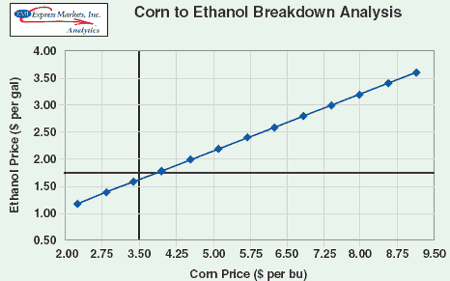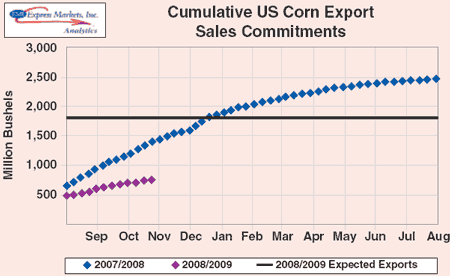



Economic Slowdown Affects Feed Ingredient Markets
The global economic crisis is adding to the problems in the world feed ingredient markets, writes Eric Scholer, manager of Express Markets Inc in the latest issue of Cobb's Business Focus.Corn and soybean meal have both declined nearly 50 per cent since the highs set last year due to the global economic slowdown. Speculative activity in grains contributed to some of the increase in corn and soybean meal markets.
Long-term global demand for commodities has declined and is expected to remain low with slowing corn exports, ethanol plant bankruptcies, cutbacks in US protein production and declining usage of all goods due to the weakening global economy. These concerns have caused commodity traders to reduce their positions contributing to the downturn in the grain markets.

Express Markets Inc.
During the late 1990's, policies were passed that deregulated some restrictions for trading commodities for commodity funds, and this caused significant growth. In 2000, there was an estimated $20 billion managed by commodity funds and, as of April 2008, there was an estimated $235 billion - a more than ten-fold increase in eight years.
These three main types of commodity funds include index funds, hedge funds and speculative funds – all holding commodities for different reasons, such as using them for an inflation hedge, looking for speculative gains or creating an index similar to a stock index and re-allocating the percentage of holdings of each commodity as their values change. They have contributed to increased volatility in commodities.
The increased trading and speculation contributed to grain prices moving to record levels, even though supplies of grain were at levels similar to 2006. As you can see in Figure 1, the current stocks-to-use ratio for world coarse grains for 2008 was near 13.5 per cent, similar to the levels seen during 2006 when the corn markets averaged just over $3.00 a bushel. Part of the increase in corn values is due to increased trading activity and part is due to a shift in corn demand.

The demand for corn from ethanol has placed a new value on corn, making it tied more directly with energy markets. Ethanol plants can place a higher value on corn during strong energy markets and a lower value during weaker markets. The new usage also added additional risk to the market place as we need a larger supply than in the past to satisfy demand and if any shortfalls occur, the impact to market values is likely to be greater.
Triggering the decline in corn was the economic slowdown and concerns over the long-term demand expectations. Exports from the US have been increasing over the past few years due to global growth in the demand for feed ingredients, a weak US dollar and crop failures in other parts of the world limiting availability of coarse grains.
Exports from the 2007/2008 crop year totalled 2.43 billion bushels, which was up nearly 15 per cent from the previous year. Exports are based on a marketing year total which, for the 2007 harvested crop would be September 2007 to August 2008. The marketing year for 2008 began in September for corn and soybeans. Exports for the 2008 crop year are estimated to total 1.9 billion bushels, down 22 per cent. So far, corn export commitments are 45 per cent below last year at this time. The first four months of the marketing year is when the bulk of the exports sales have historically occurred.

For the past five years, by mid-November, 42 per cent of the expected exports had already been committed for export. This year we only have 37 per cent of the estimated 1.9 billion bushels committed. This is an indication that export demand may actually be down more than is currently anticipated and is contributing to the downturn in the corn market values.
Exports from the US are estimated to decline due to a strengthening US dollar and the continued decline in the global economy. Energy markets also declined causing ethanol markets to drop and tighten margins for ethanol plants. The chart shows the break-even points to cover variable costs for an average ethanol plant. Plants are very close to break-even with the current ethanol and corn values. Corn use for ethanol is down over 10 per cent from what was previously expected due to the poor returns.
The US ethanol industry currently has the capacity to produce 12 billion gallons of ethanol, which is well above the mandated 10.5 billion gallon usage for 2009. Now that energies have declined considerably, the willingness to blend ethanol is expected to decline because the value of ethanol is higher than gasoline futures. It is expected that the industry will only produce to the mandated levels unless there are additional subsidies added.
From the 2008 crop, it is estimated that the US will consume 3.7 billion bushels of corn or 30 per cent of this year's production, which is below the ethanol industries production capacity. There are currently 178 ethanol facilities in production with another 35 that are under construction. However, 15 plants are currently shut down and several companies filing for bankruptcy. The unprofitable conditions will likely contribute to lower than expected corn use and contribute to more moderate corn prices in 2009.
The future for corn and soy values is dependent on the ability of the US and world economies to recover, energy markets and grain production decisions. Both corn and meal are expected to trend higher as we approach spring. Production costs for corn have increased significantly and will likely cause grain producers to shift more acres to soybeans, which would imply that corn markets need to move higher before spring to stimulate increased production.

However, markets are not anticipated to reach anywhere near the levels we did during 2008 due to less commodity fund trading and reduced global demand for feed grains. Grain markets are still expected to be high from a historical standpoint with corn estimated to average $4.00 a bushel on the CBOT for all of 2009 and soybean meal at $265 a ton.
The tightening of credit has been one of the major contributors to the reduced export demand as international buyers are having more difficulty getting credit lines to make grain purchases. Until the global economy stabilizes and begins to grow, it is not expected that grain markets will move to levels similar to 2008 unless significant weather problems occur.
Even though feed ingredient prices have declined, this does not mean that US protein producers have returned to profitability because global demand for protein has declined as well. The US and global economies are likely to continue to decline through at least the first half of 2009 before the financial markets stabilize and recovery is expected to be gradual. That should imply that grain markets will probably stabilize at higher than normal values from a historical standpoint, assuming there are no significant policy changes to renewable energy.
Before joining EMI, Eric Scholer was with Risk Management Commodities Inc. as an analyst for a broad range of commodities including grains, livestock, metals and energies with a focus primarily on grains. He worked with many grain and livestock producers providing hedge recommendations for their operations. He has a Master's degree in agricultural economics from Purdue University after completing a thesis on new grain marketing contracts and their usefulness for producers. He also received a Bachelor's degree in agricultural economics with a minor in Agronomy from Purdue.
February 2009











